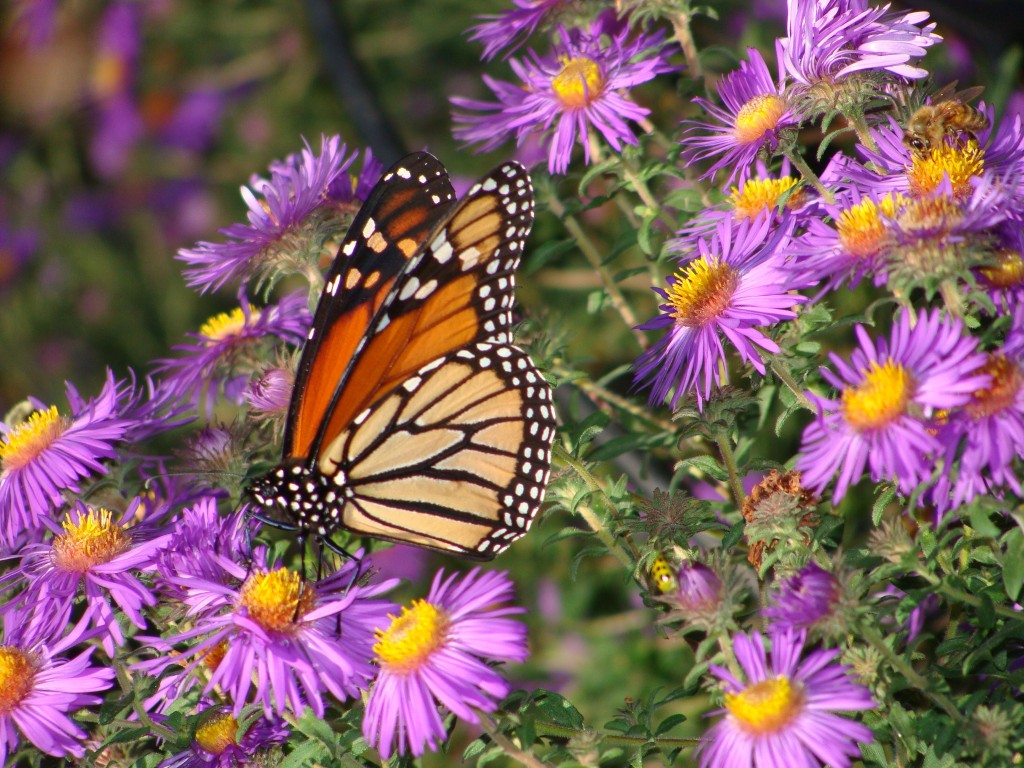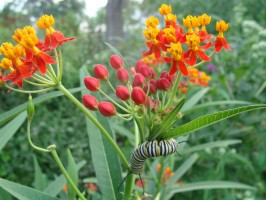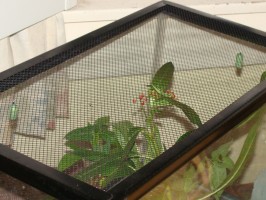
Monarch butterfly sipping nectar from a New England Aster.
Even though it’s October, be on the watch for monarch caterpillars on milkweed (including vining milkweed) and chrysalises in your garden. And possibly elsewhere – my neighbor discovered a chrysalis inside a running shoe left out on his porch.
 Last weekend I found three monarch caterpillars – two on tropical milkweed, and one on vining milkweed. All were at different instars or stages, and two have pupated. Chances are, if you have milkweed, you may have monarch caterpillars and chrysalises, too.
Last weekend I found three monarch caterpillars – two on tropical milkweed, and one on vining milkweed. All were at different instars or stages, and two have pupated. Chances are, if you have milkweed, you may have monarch caterpillars and chrysalises, too.
To protect the caterpillars from birds and other predators, I put them in an aquarium away from direct sun with small-necked vases to hold their breakfast, lunch and dinner – milkweed.
The aquarium cover is important – it’s a reptile-style top with a heavy, coarse mesh rather than a screen that resembles window screen. The cover’s spaces are wide enough to make it easy for the cats to hang and pupate. Window screen-style covers do not encourage pupation – the fine mesh is too closely woven.
 I find it easier to track the progress of the chrysalis at the top of the tank than elsewhere. Typically, the green chrysalis begins to darken the day before and the butterfly wings show through as the time nears for the monarch to emerge.
I find it easier to track the progress of the chrysalis at the top of the tank than elsewhere. Typically, the green chrysalis begins to darken the day before and the butterfly wings show through as the time nears for the monarch to emerge.
In my limited experience, monarch butterflies break free at about 6 a.m. And they’re ready for releasing in the garden not long after – a magical moment if ever there was one. It’s like a piece of your heart taking wing.
I’m pretty sure that if they live, these monarchs will head out of my St. Charles garden on their way to their overwintering site in Mexico.
As it happens, we can look forward to seeing a 3-D documentary about the monarch migration, Flight of the Butterflies, opening at the St. Louis Science Center on January 18, 2013. (Thanks for letting us know, Brian Hall!)
By Peg Whetzel
http://www.youtube.com/watch?v=WTnOY_qTB2c

